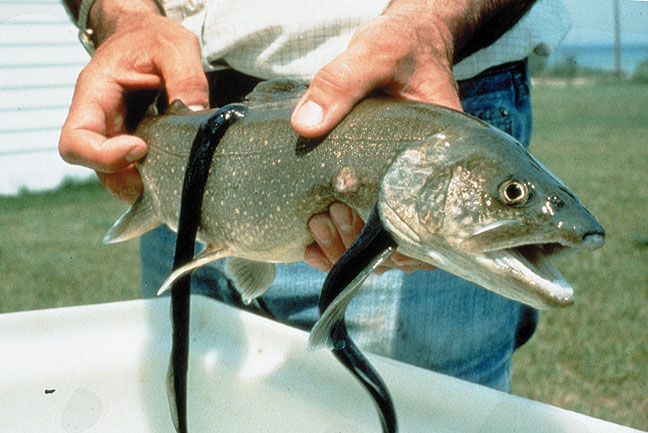- Sea lamprey
Taxobox
name = "Petromyzon marinus"

status = LR/lc | status_system = IUCN2.3
image_caption = Sea lampreys on alake trout
regnum =Animal ia
phylum =Chordata
classis =Cephalaspidomorphi
ordo =Petromyzontiformes
familia =Petromyzontidae
genus = "Petromyzon"
species = "P. marinus"
binomial = "Petromyzon marinus"
binomial_authority = (Linnaeus,1758 )The sea lamprey ("Petromyzon marinus") is a
parasitic lamprey (a kind ofjawless fish ) found on theAtlantic coasts ofEurope andNorth America , in the western Mediterranean Sea, and in theGreat Lakes . It is brown or gray on its back and white or gray on the underside and can grow to be up to 90 cm (35.5 in) long. Sea lampreys prey on a wide variety of fish. The lamprey uses its suction-cup like mouth to attach itself to the skin of a fish and rasps away tissue with its sharp probing tongue and teeth. Secretions in the lamprey's mouth prevent the victim's blood from clotting. Victims typically die from blood loss or infection.The life cycle of sea lampreys is
anadromous , like that ofsalmon .The young are born in inland rivers, live in the ocean as adults, and return to the rivers to breed. Young emerge from the egg as larvae, blind and toothless, and live that way for 3 to 17 years, buried in mud and filter-feeding. Once they have grown to a certain length, they metamorphosize into their parasitic form, after which they migrate to the sea. After about 12 to 20 months, they metamorphosize into their adult form and return to the rivers and streams and spawn, after which they die.Sea lampreys are considered a pest
invasive species in the Great Lakes region. The species is native to the inlandFinger Lakes andLake Champlain in New York and Vermont. It is not clear whether it is native toLake Ontario , where it was first noticed in the 1830s, or whether it was introduced through theErie Canal , which opened in 1825. [ [http://nas.er.usgs.gov/queries/FactSheet.asp?speciesID=836 Nonindigenous Aquatic Species Factsheet: Petromyzon marinus] U.S. Geological Survey (USGS), Nonindigenous Aquatic Species Program (NAS). Retrieved on2007 -08-04 .] It is thought that improvements to theWelland Canal in 1919 allowed its spread from Lake Ontario to Lake Erie, and while it was never abundant in either lake, it soon spread toLake Michigan ,Lake Huron , andLake Superior , where it decimated indigenous fish population in the 1930s and 1940s. They have created a problem with their aggressive parasitism on key predator species and game fish, such aslake trout ,lake whitefish , chub, and lake herring. Elimination of these predators allowed thealewife , another invasive species, to explode in population, having adverse effects on many native fish species. Control efforts, including electric current, chemical lampricides, and barriers, have met with varied success. The control programs are carried out under the Great Lakes Fisheries Commission, a joint Canada-US body, specifically by the agents of the GLFC,Fisheries and Oceans Canada , and theUnited States Fish and Wildlife Service .Genetic researchers have begun mapping the sea lamprey's genome in the hope of finding out more about evolution; scientists trying to eliminate the Great Lakes problem are co-ordinating with these genetic scientists, hoping to find out more about its immune system and fitting it into its place in the phylogenetic tree. Several scientists in this field work directly for
Fisheries and Oceans Canada or theUnited States Fish and Wildlife Service . Researchers from Michigan State University have teamed up with others from the Universities of Minnesota, Guelph, Wisconsin, as well as many others in a massive research effort into newly synthesized pheromones. These are believed to have independent influences on the sea lamprey behavior. One pheromone serves a migratory function in that odor emitted from larva are thought to lure maturing adults into streams with suitable spawning habitat; the other, a sex pheromone, is emitted from males and is capable of luring females long distances to very specific locations - even in complete darkness and even though many lamprey at this stage in their life have strongly degraded eyesight. These two pheromones are actually both several different compounds that are thought to elicit different behaviors that collectively influence the lamprey to exhibit migratory behaviors or spawning behaviors. Effort is being made to characterize the function of each pheromone, each part of each pheromone, and if they can be used in a targeted effort at environmentally friendly lamprey control. It is the hope of the Great Lakes Fisheries Commission that at least some of this brilliant work into sea lamprey genetics as well as pheromones will pan out into a successful, effective management technique that could one day drastically reduce the need for TFM treatments of spawning grounds. Despite millions put into research however, the most effective control measures are still being undertaken by control agents of State and Federal Agencies but involve the somewhat publicly unacceptable dumping of TFM into our nation’s rivers.In 1996, the University of Minnesota - Duluth decided to try a lamprey taste test. Many dishes were prepared by chef Bob Bennet, of Bennets Bar & Grill in
Duluth, Minnesota . Among the dishes were combinations like Lamprey Stew & Garlic Mashed Potatoes, and Arroz de Lampreia (lamprey rice). Doug Jensen, aquatic invasive species coordinator for UMN Sea Grant, was among the testers. He said it tasted actually pretty good. [ [http://www.sciencenews.org/pages/sn_arch/8_10_96/food.htm Science News Online - Food for Thought - 8/10/96 ] ]References
Wikimedia Foundation. 2010.
